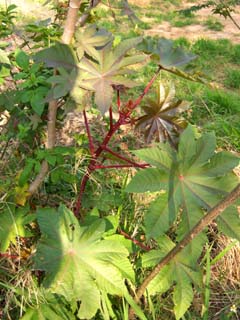Ricinus communis Informationen
Identification:
The glossy leaves are 15–45 centimetres (5.9–18 in) long, long-stalked, alternate and palmate with 5–12 deep lobes with coarsely toothed segments. Their colour varies from dark green, sometimes with a reddish tinge, to dark reddish purple or bronze. The stems and the spherical, spiny seed pods also vary in pigmentation. The pods are more showy than the flowers the male flowers are yellowish-green with prominent creamy stamens and are carried in ovoid spikes up to 15 centimetres (5.9 in) long; the female flowers, borne at the tips of the spikes, have prominent red stigmas. Castor seed is the source of castor oil, which has a wide variety of uses. The seed coat contains ricin, a toxin, which is also present in lower concentrations throughout the plant, and is harmful in large quantities.
Allgemeine Informationen:
It is a fast-growing, suckering perennial shrub which can reach the size of a small tree (around 12 metres/39 feet), but it is not hardy. However it grows well outside, at least in Southern England, and the leaves do not appear to suffer frost damage in sheltered spots, where it remains evergreen. In areas prone to frost it is usually shorter and grown as if it were an annual. If sown early, under glass, and kept at a temperature of around 20°C (68°F) until planted out, the castor oil plant can reach a height of 2–3 metres (6.6–9.8 ft) in a year.
Verteilung:
Heimisch in
Unfertige Erzeugnisse
Informationen zum Vertrieb derzeit überarbeitet!

